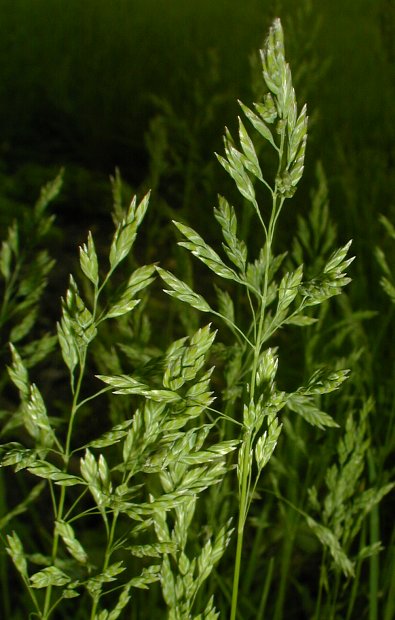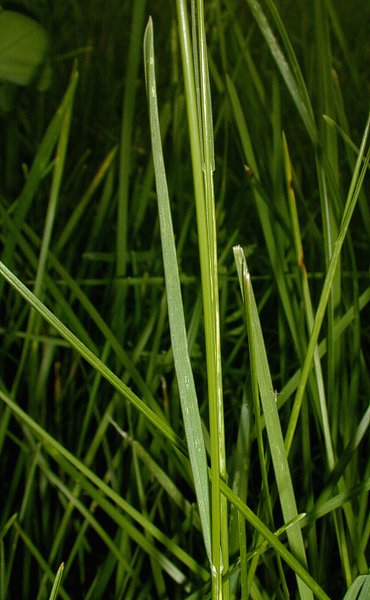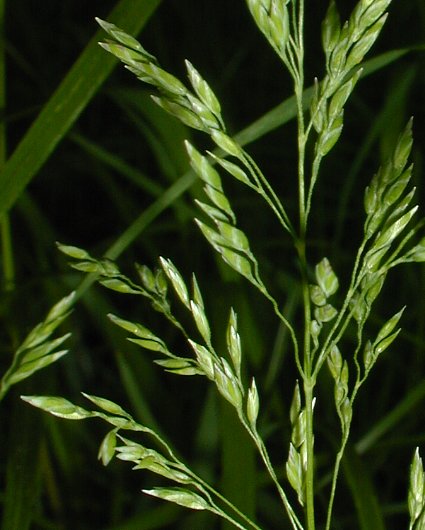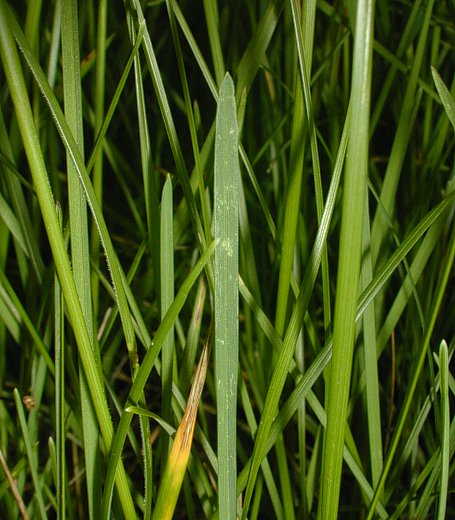Description: This perennial grass produces flowering culms that are 1–2½' tall; basal leaves are also produced from infertile shoots. The slender culms are light green, terete to slightly flattened, glabrous, unbranched, and more or less erect; there are 2-5 alternate leaves per culm. The leaf blades are 2-6 mm. across and 2-5" long; they are medium green, hairless (or nearly so), and ascending to widely spreading. The tips of the leaves are hull-shaped. The basal leaves are similar to the alternate leaves, except they are usually more long and floppy. The basal leaves are partially evergreen, while the flowering culms with alternate leaves die down after the grains ripen. The sheaths are medium green, longitudinally veined, and hairless (or nearly so); they are open from their apices to at least the middle of their internodes. Each fertile culm terminates in a panicle of spikelets about 2-6" long. In outline, the open panicle is oblongoid-pyramidal or narrowly pyramidal. The rachis (central stalk) of the panicle, its lateral branches, and pedicels are very slender and glabrous (or nearly so). Lateral branches of varying length occur in whorls of 2-5 along the rachis; they are ascending to widely spreading. The lateral branches divide and subdivide into pediceled spikelets. Individual spikelets are 4-6 mm. long, while their pedicels are up to 2 mm. long.

The spikelets are light green to purplish green. Each spikelet consists of a pair of glumes at the bottom and 2-5 lemmas above; the glumes and lemmas are arranged into 2 overlapping ranks. The glumes are 2.5–3.5 mm. long, lanceolate, membranous along their margins, and convex to slightly keeled along their outer sides; each glume has 1-3 fine veins. The lemmas are 3-4 mm. long, lanceolate, membranous along their margins, and convex to slightly keeled along their outer sides; each lemma has 5 fine veins. The midvein and marginal veins are finely hairy along the lower half of each lemma, while the intermediate veins are hairless. At the base of each lemma, there is a small tuft of fine webby hairs. The lemmas and their membranous paleas enclose perfect florets. Each floret has 3 stamens and a pair of feathery stigmata. The blooming period usually occurs from late spring to early summer, lasting about 2 weeks. The florets are cross-pollinated by the wind. Afterwards, the spikelets become light tan or light brown at maturity. Each fertile lemma produces a single grain (some upper lemmas within each spikelet may be sterile). The grains are about 2 mm. long, light brown, narrowly ellipsoid in shape, and grooved along one side. The root system is fibrous and long-rhizomatous. This grass often forms clonal colonies of plants from the rhizomes. There is some variability across different strains of this grass.

Cultivation:
The preference is full to partial sun, mesic conditions, cool to warm
temperatures, and fertile soil consisting of loam or clay-loam with a
slightly acid to alkaline pH. Hot dry weather during the summer can
cause this cool-season grass to die out in patches if it is not watered.
Range & Habitat:
Kentucky Bluegrass occurs in every county of Illinois and it is quite
common (see Distribution
Map). It was introduced into North America from Europe as a
lawn grass and
pasture grass. Habitats include lawns, parks, pastures, roadsides,
degraded prairies, weedy meadows, vacant lots, waste areas,
open woodlands, savannas, limestone glades, and gravelly seeps.
This grass is usually found in areas with a history of human-related
disturbance. While it is not considered a major invasive species (at
least in
Illinois), it is often found in some native habitats as described
above. Its capacity to recover from wildfires is poor.

Faunal Associations: Kentucky Bluegrass is an attractive source of food to many insects. Many grasshoppers are known to feed on the foliage (see Grasshopper Table) of this grass, particularly in areas that are not regularly mowed. The caterpillars of several butterflies and skippers also feed on the foliage; these include Cercyonis pegala (Common Wood Nymph), Megisto cymela (Little Wood Satyr), Amblyscirtes hegon (Pepper-and-Salt Skipper), Ancyloxypha numitor (Least Skipper), Hylephila phyleus (Fiery Skipper), Polites peckius (Peck's Skipper), and Polites themistocles (Tawny-Edged Skipper). Other insects that feed on Kentucky Bluegrass include larvae of the moth Arugisa latiorella (Common Arugisa), Leptoterna dolobratus (Meadow Plant Bug) and Trigonotylus caelestialium (Rice Leaf Bug), several stinkbugs, Schizaphis graminum (Greenbug) and other aphids, the leafhopper Latalus sayii, Sphenophorus parvulus (Bluegrass Billbug) and Sphenophorus zeae (Timothy Billbug), Oulema melanopus (Cereal Leaf Beetle), Ataenius spretulus (Black Fairway Beetle) and Cyclocephala borealis (Northern Masked Chafer), larvae of the gall wasps Tetramesa captivum and Tetramesa maculata, larvae of the fly Cerodontha dorsalis (Grass Sheath Miner), larvae of the gall fly Isocolpodia graminis, Gryllus pennsylvanicus (Fall Field Cricket), and the thrips Anaphothrips obscura. Among vertebrate animals, the foliage of Kentucky Bluegrass is a major source of food for the Canada Goose, particularly in parks with ponds. Birds that eat the seeds or seedheads include the Wild Turkey, Ring-Necked Pheasant, Greater Prairie Chicken, Mourning Dove, Field Sparrow, and House Sparrow. Kentucky Blue Grass provides preferred pasturage to horses, cattle, and other livestock; it is also eaten by the Cottontail Rabbit and Meadow Vole.

Photographic
Location:
A lawn at the apartment complex of the webmaster in Urbana, Illinois.
Comments:
This grass has been introduced everywhere and it has become ubiquitous.
It is undoubtedly the most common bluegrass in Illinois. Distinguishing
different bluegrass species (Poa
spp.) can
be difficult; this task often requires a 10x hand lens or a 30x field
microscope while examining the lemmas
of the spikelets. Because many different cultivars have been developed,
Kentucky Bluegrass (Poa
pratensis) is both genetically and morphologically
diverse. Unlike some species in this genus, Kentucky Bluegrass
forms a turf from long rhizomes. Its lemmas have 5 visible veins;
the midvein and marginal veins are finely hairy on
the lower half of each
lemma, while the intermediate veins are hairless. Other bluegrass
species are finely hairy along the intermediate veins as well, or they
may lack fine hairs along the veins of their lemmas altogether. As a
group,
bluegrass species differ from many other grasses by the small tufts of
webby hair
that are usually found at the bottom of their lemmas.